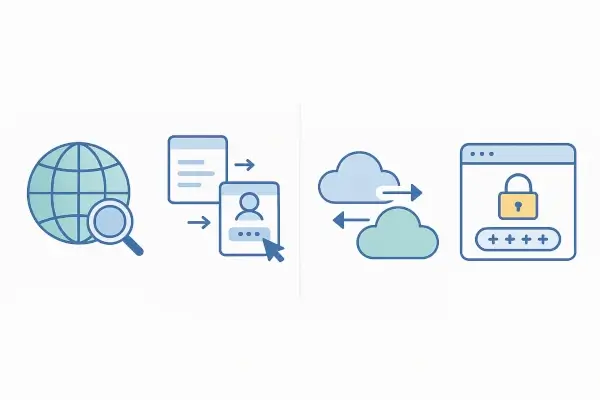
Key Takeaways
- Synthetic transaction monitoring proactively measures web application performance by simulating user interactions to identify issues before they impact real users.
- This monitoring approach offers several benefits, including significant reductions in customer-reported issues and preparation for product launches by addressing performance bottlenecks in advance.
- Effective synthetic monitoring relies on best practices, such as creating accurate scripts that mimic real user behavior, conducting tests from multiple locations, and integrating with real user monitoring for comprehensive performance insights.
Table of Contents:
What is Synthetic Transaction Monitoring?
How does Synthetic Transaction Monitoring Work?
Types of Synthetic Transactions
Synthetic Transaction Monitoring vs. Real User Monitoring?
Application Performance and Synthetic Monitoring
Benefits
Challenges
Best Practices
Use Cases
How to Measure Success in Synthetic Transaction Monitoring?
Emerging Trends
Conclusion
FAQ
What is Synthetic Transaction Monitoring?
Synthetic transaction monitoring, or web application monitoring, is a proactive method designed to measure and test web application performance through simulated transactions. Synthetic monitoring evaluates web application performance by simulating user interactions. During these simulated interactions, synthetic monitoring tools collect data on the web application's performance, including responsiveness and load times. This approach is about identifying and preventing issues before they affect end users.
Synthetic monitoring proactively detects performance bottlenecks. By replicating the end user's experience, synthetic monitoring assesses the application's performance to identify potential issues before they impact users. Custom scripts simulate user actions in business-critical scenarios, identifying potential issues before they affect users. Configured to operate both within a company's network and from external locations, synthetic monitoring provides comprehensive performance insights.
Synthetic monitoring tools:
- Execute tests continuously, tracking performance around the clock.
- Assess an application's responsiveness and availability from various geographic locations.
- Provide businesses with a holistic view of their application components' performance.
How does Synthetic Transaction Monitoring Work?

Synthetic monitoring (a.k.a. web transaction monitoring) involves a robot client application that automates user transactions, simulating real user interactions with a website or application. This process generates network traffic and server calls to simulate real user activity and test application responsiveness. It is essential for identifying potential issues before they affect actual users. TEA (Transaction Execution Agents) play a crucial role in this setup by executing the scripts and reporting the results, ensuring that the simulated transactions closely mimic real user behavior.
One key advantage of synthetic monitoring is its ability to test application behavior from various geographical locations, including multiple locations. Synthetic monitoring can be configured to test interactions with remote servers and within different test environments, helping to identify issues before they impact customers.
It is important to whitelist the IP addresses used by synthetic monitoring tools to ensure that security systems or firewalls do not block the tests, which could otherwise prevent accurate performance assessments. Strategically chosen monitoring locations allow businesses to assess application performance across different locations, offering a comprehensive view of potential issues.
Continuous testing with synthetic monitoring tools ensures consistent application performance monitoring. This ongoing assessment alerts businesses to service outages or performance degradations promptly, facilitating quick responses and minimizing downtime with a robust monitoring system.
Types of Synthetic Transactions

Synthetic transactions come in various forms, each serving a specific purpose in assessing application performance. API monitoring, for example, includes methods that assess the availability and performance of specific api endpoints used by applications. Synthetic tests within API monitoring can include HTTP, SSL, and DNS tests, ensuring that different aspects of API functionality are monitored. Additionally, synthetic monitoring can test web services as part of transaction scripts to verify that APIs and related web services are functioning as expected.
Browser tests are another critical type of synthetic transaction. These tests simulate user actions in an actual browser monitor, allowing for the evaluation of webpage functionality and performance across different browsers. Browser tests also monitor client-side performance metrics, such as page load times, to ensure optimal user experience. By mimicking real user interactions, browser tests help identify any issues that might affect the user experience, ensuring that web pages perform optimally.
Multi-step user journey simulations provide insights into how different user interactions unfold. These simulations are crucial for identifying bottlenecks within complex workflows, ensuring that the entire user journey is seamless and effective. Synthetic monitoring can simulate the end user's clickstream to track web transactions and interactions within a web app, helping to identify issues at each step. By tracking a complete workflow of an application process, multi-step API tests ensure that everything functions correctly from start to finish.
What is the Difference between Synthetic Transaction Monitoring and Real User Monitoring?

Synthetic transaction monitoring and real user monitoring each offer unique advantages in web application monitoring. Synthetic monitoring lets organizations identify performance and user experience issues before they impact real users. Synthetic monitoring can proactively identify issues and provide immediate alerts about service outages by simulating user journeys in a controlled environment, enabling quick responses and reducing downtime.
In contrast, real user monitoring tracks actual user interactions, providing insights into how real users interact with the application and utilizing real user data. While synthetic monitoring can test scenarios in pre-production environments to ensure new features perform well before they go live, real user monitoring cannot operate in such environments. Integrating synthetic monitoring with real user monitoring and other analytics tools offers a comprehensive view of application performance and real user traffic.
One key benefit of synthetic monitoring is its ability to test new features in a controlled environment, ensuring they perform well before being released to real users. This proactive approach fosters collaboration between technical and non-technical teams by focusing on user-centric performance metrics. Combining synthetic and real user monitoring provides a holistic view of performance, capturing both simulated and actual user experiences.
By emulating user actions, synthetic monitoring ensures that potential issues are identified and addressed before they impact real users. This proactive monitoring, combined with the reactive insights from real user monitoring, creates a robust application performance monitoring strategy that ensures optimal user satisfaction.
Application Performance and Synthetic Monitoring

Application performance is at the heart of delivering exceptional digital experiences, especially for businesses that depend on web applications to serve their customers. Synthetic monitoring is a powerful technique that enables organizations to monitor web applications by simulating user interactions, such as logging in, browsing, or completing a purchase. Using synthetic monitoring tools, businesses can proactively identify performance issues before they impact actual users, ensuring a seamless experience even during low real user traffic periods.
One of the key strengths of synthetic monitoring solutions is their ability to monitor web applications from multiple locations around the globe. This approach provides a comprehensive view of application performance, helping to uncover issues that may only affect users in specific geographic locations or under certain network conditions. By monitoring web applications from different locations, organizations can ensure consistent performance for all users, regardless of where they access the service.
Synthetic monitoring tools also allow businesses to monitor specific workflows, such as checkout processes or login procedures, to verify that these critical paths function correctly. This targeted approach to monitoring web applications helps maintain high standards of reliability and user satisfaction. Ultimately, synthetic monitoring empowers businesses to deliver robust, high-performing web applications and maintain a competitive edge in today's digital landscape.
What are the Benefits of Synthetic Transaction Monitoring?

The benefits of synthetic transaction monitoring are numerous and impactful. Performance data collected during synthetic monitoring helps identify and resolve potential user experience issues proactively. This proactive approach significantly reduces the number of customer-reported issues by up to 95%, ensuring a smoother and more reliable user experience.
Synthetic monitoring also helps businesses prepare for launching new products by identifying and fixing performance bottlenecks ahead of time. By regularly analyzing monitoring results, businesses can optimize performance and address any emerging issues, ensuring that new features and updates are rolled out seamlessly. This is where synthetic monitoring work and synthetic monitoring solutions become essential.
In addition to reducing customer-reported issues and optimizing performance, synthetic monitoring provides continuous insights into application performance. This ongoing assessment helps businesses stay ahead of potential problems, ensuring that their applications remain responsive and reliable, ultimately enhancing user satisfaction, leading to a higher UX ROI and business success.
What Challenges does Synthetic Transaction Monitoring have?

Despite its many benefits, synthetic transaction monitoring comes with its challenges. Maintaining accurate scripts is crucial, as changes in the application can lead to outdated or ineffective monitoring. This requires constant updates and adjustments to ensure the monitoring remains relevant and effective.
Dynamic website content poses another challenge, requiring scripts to adapt to variable elements for effective monitoring. Interpreting performance data can also be complex, often necessitating deep analysis to distinguish between genuine issues and normal variations. This complexity can make identifying the root causes of code performance problems difficult.
Accurately simulating real user interactions is inherently challenging due to the variability in user behavior and environmental conditions. Consistency in network conditions during tests is essential for reliable results, but it can be difficult to control across different environments. These challenges highlight the need for careful planning and execution in synthetic transaction monitoring.
Best Practices for Effective Synthetic Transaction Monitoring

Effective synthetic transaction monitoring requires best practices for the end user. Start by creating scripts covering all critical user pathways and application functionalities, identifying and addressing potential issues.
Designing testing scripts that closely imitate real user behavior is also crucial. This includes accounting for varying devices and browsers to ensure that the monitoring reflects the diverse ways user activity occurs as users interact with the application. Conducting tests from multiple geographical locations helps identify regional performance issues, providing a holistic view of application performance.
Balancing the frequency of synthetic monitoring tests is important to maintain oversight without incurring excessive costs. Regular testing ensures continuous monitoring of application performance, while strategic timing helps manage resources effectively. By following these best practices, businesses can ensure consistent performance and a seamless user experience.
Use Cases for Synthetic Transaction Monitoring

Synthetic transaction monitoring is widely applicable across several industries, ensuring that essential user journeys are always seamless and effective. In e-commerce, synthetic monitoring is essential for tracking the entire customer journey, including product searches and checkout processes. For online banking, synthetic transaction monitoring tests processes such as login, fund transfers, and bill payments to ensure platforms are responsive.
Healthcare technologies utilize synthetic monitoring to verify the performance of Electronic Health Record systems and patient portals. SaaS applications benefit from synthetic monitoring by ensuring robust core functionalities like user registration and API performance.
It is crucial to ensure that booking systems constantly work in the travel and hospitality domains. Synthetic transaction monitoring helps guarantee that their systems can handle booking volumes without users facing any difficulties during peak times.
Media and content delivery sectors use synthetic monitoring to assess video streaming performance and playback quality across various regions.
For businesses that need to meet SOX software compliance, synthetic transaction monitoring helps ensure alignment with obligations to maintain accurate financial reporting by verifying that the website performs consistently for users worldwide.
Continuous monitoring and optimizing these critical infrastructure components enable businesses across industries to deliver exceptional digital experiences with advanced capabilities and service-level agreements to their users.
How to Measure Success in Synthetic Transaction Monitoring?

Measuring the success of synthetic transaction monitoring is essential for optimizing web applications and ensuring a superior digital experience. Key performance indicators (KPIs) such as response time, error rates, and user satisfaction provide valuable insights into how well your application is performing. Synthetic monitoring tools generate detailed reports on these metrics, enabling businesses to pinpoint performance issues and areas for improvement.
Transaction monitoring can be extended to specific application components, such as APIs or databases, allowing organizations to identify and resolve bottlenecks that could affect the overall user experience. By simulating synthetic transactions at regular intervals, businesses can test how their web applications perform under various scenarios, including high traffic or network congestion, ensuring resilience and reliability.
To maximize the benefits of synthetic monitoring, it's important to set clear goals, such as reducing response times or increasing user satisfaction, and track progress over time. Regular analysis of performance data helps refine monitoring strategies and ensures that web applications continue to meet user expectations. By leveraging synthetic monitoring tools and focusing on continuous improvement, businesses can maintain optimal application performance and deliver a consistently positive digital experience.
Emerging Trends in Synthetic Transaction Monitoring

Synthetic transaction monitoring is rapidly evolving, with new technologies and methodologies enhancing its effectiveness. One of the most significant trends is the integration of artificial intelligence (AI) and machine learning (ML) into synthetic monitoring solutions. These advanced capabilities enable monitoring tools to analyze vast amounts of performance data, detect patterns, and predict potential performance issues before they impact users. By leveraging AI and ML, businesses can move from reactive to predictive application performance monitoring.
Cloud-based synthetic monitoring solutions are also gaining traction, offering greater flexibility and scalability. With cloud-based monitoring, organizations can monitor web applications from virtually any location, without the need for extensive on-premises infrastructure. This approach reduces costs and ensures that monitoring can keep pace with the dynamic nature of modern web applications.
The rise of mobile apps and push notifications is another key trend in synthetic transaction monitoring. Mobile apps allow businesses to simulate user interactions on various devices, ensuring optimal performance across platforms. Push notifications provide real-time alerts about performance issues, enabling teams to respond quickly and maintain high levels of user satisfaction.
By embracing these emerging trends, AI and machine learning, cloud-based monitoring solutions, and mobile app integration, businesses can avoid performance issues and deliver exceptional digital experiences through robust synthetic transaction monitoring.
Get Started with Web Transaction Monitoring Now ![]()
Conclusion
Synthetic transaction monitoring offers a proactive approach to web application performance, allowing businesses to stay ahead of potential problems and deliver exceptional digital experiences. By simulating user journeys, synthetic monitoring helps identify and resolve performance bottlenecks before they impact real users. Integrating synthetic monitoring with real user monitoring provides a comprehensive view of application performance, ensuring all potential issues, such as slow performance, images failing to load, or glitches, are addressed.
With the right tools and best practices, businesses can implement a robust synthetic transaction monitoring strategy that ensures consistent application performance and user satisfaction. Start implementing synthetic transaction monitoring today and unlock the secrets to a seamless digital experience.
Frequently Asked Questions (FAQ)
What is synthetic transaction monitoring?
Synthetic transaction monitoring is a proactive approach that assesses web application performance using simulated transactions replicating user interactions. This method ensures that applications function optimally for real users.
How does synthetic transaction monitoring work?
Synthetic transaction monitoring automates user interactions with an application to simulate real user behavior, utilizing TEA agents to execute scripts and report outcomes. This method ensures continuous oversight and performance evaluation of the application.
What are the benefits of synthetic transaction monitoring?
Synthetic transaction monitoring provides significant advantages such as proactive issue identification and a substantial reduction in customer-reported issues, potentially by up to 95%. Additionally, it aids in optimizing application performance, particularly for new product launches.
What are the challenges in synthetic transaction monitoring?
The primary challenges in synthetic transaction monitoring involve ensuring the accuracy of scripts, adapting to ever-changing content, accurately interpreting complex performance data, and effectively simulating genuine user interactions. These factors are crucial for reliable monitoring outcomes.
How do I get started with synthetic transaction monitoring?
To get started with synthetic transaction monitoring, visit WebSitePulse's Web Transaction Monitoring Service and sign up.


 Copyright 2000-2025, WebSitePulse. All rights reserved.
Copyright 2000-2025, WebSitePulse. All rights reserved.